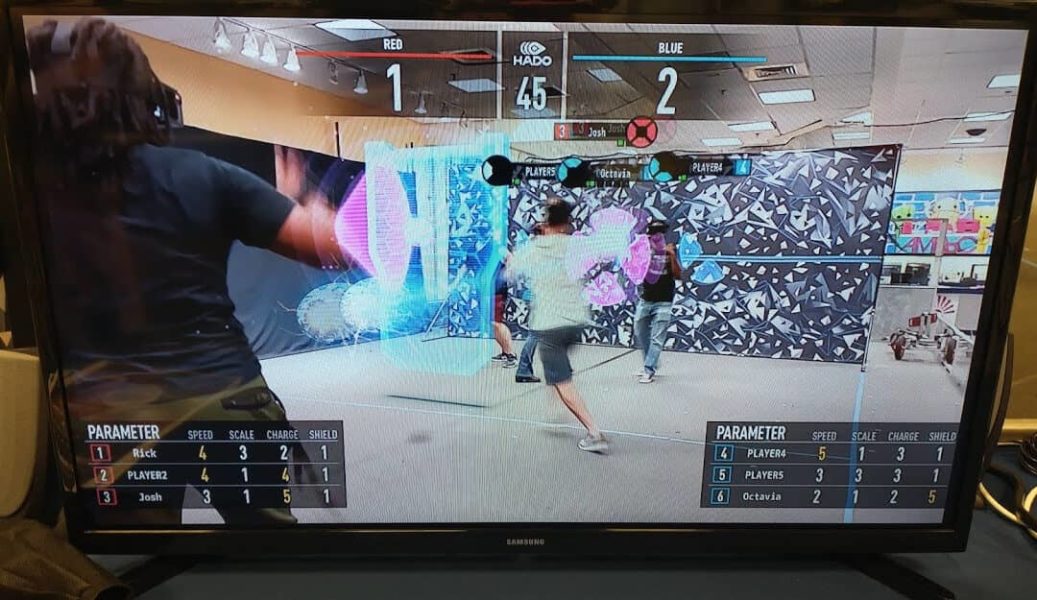
Hado bringing augmented reality gaming to Synapse Summit
The futuristic, augmented reality eSport Hado is coming to Tampa for this year’s Synapse Summit, offering attendees the chance to throw virtual balls of electricity at their opponents across the floor of Amalie Arena.
Developed in Japan in 2014, around 37 countries currently play the competitive eSport, according to Shane Vander Kooi, co-founder of Hado USA. However, Hado is mostly unknown outside of Asia and Europe, and Palm Beach-based Hado USA hopes the Synapse Summit on Feb. 17 is a coming-out party for its American aspirations.
Hado consists of two teams of up to three players, although variations in the game allow players to challenge computer-generated avatars or play with fewer people. The game takes place in a physical court or space – called a Hado Arena. The game can exist anywhere, although operators need a space about a third of the size of a tennis court.
“They can be popped up outdoors, but very often it’s inside a physical location like a gym, large classroom or convention center,” explained Vander Kooi. “In Synapse’s case, it’s going to be on the main floor in Amalie Arena.”
Players wear an augmented reality headset that provides a view of the playing field and opponents. Players also wear a device on their wrists, which Vander Kooi said is essentially an iPod Touch. The headset overlays augmented reality aspects, such as energy balls that players launch at one another. Vander Kooi likened the game to dodgeball, except the red rubber balls are now blue digital balls of virtual energy.
Players also see the virtual shields worn by opponents, health meters and a game clock. Players rapidly move to avoid the energy balls while waving their arms to throw counter strikes.
“One of my partners actually described it as almost like dodgeball meets Marvel or The Avengers,” said Vander Kooi. “It’s kind of a futuristic form of that.”
As an augmented reality game, players are still aware of their physical surroundings. The games are fast-paced and last 80 seconds, although one game could consist of several matches – similar to tennis. Vander Kooi said the games offer a cardiovascular workout, and most people need a break after three or four matches.
“It’s easy to play,” said Vander Kooi. “When we’re introducing this at Synapse, with a few minutes of instruction, any guest or attendee at the event will easily be able to play Hado.”
While initial gameplay is easy for beginners to pick up, Vander Kooi said learning how to strategize and play well takes more time. He noted that team members could assign 10 different points across four skill levels, defining how the team works together.
Vander Kooi explained skill points are assigned for defensive purposes, such as strengthening shields. Likewise, offensive skill points can power energy balls at faster speeds and take more of the opposition’s life petals – or health.
“It’s like any sport,” said Vander Kooi. “The more you play, the more you practice and the more you analyze, the better you can get at it.”
Vander Kooi said most of the gaming industry is becoming more immersive, engaging and physical. He said one thing that sets Hado apart is that it was the first augmented reality game to receive widespread adoption as a competitive sport.
Vander Kooi said the founders of Hado envision it as less of a video game and more as a new form of sport that happens to utilize augmented reality technology. He said the physicality of the game is unique, and it requires a centralized location for players to participate, which brings players together and encourages interaction.
“Which differs from most eSports, which are often played by team members who in some cases are not even in the same country,” said Vander Kooi.
Hado is not a straight-to-consumer game and requires an operator. Operators must hold a license from Hado, and Vander Kooi currently has exclusive rights in America. Vander Kooi said he envisions a time when consumers can operate their own games using 5g technology but as of now, the operators provide the necessary equipment and servers.
Vander Kooi hopes to find investors and partners at Synapse to help develop a Hado eSports league across the country. He looks forward to introducing the game to not only the business community but the people of Tampa Bay as well.
A key aspect of Vander Kooi’s growth strategy is creating a scholastic and collegiate eSports program with Hado. He said pilot programs prove the gameplay is enjoyable for kids while exposing them to different STEM and innovation careers. Most of all, he believes Hado is a way to bring people together and negate the negativity surrounding overexposure to video games.
“This is actually kind of fighting fire with fire,” said Vander Kooi. “It brings people together using technology and gaming but being active at the same time.”
For more information on Hado, visit its website here.
The post Hado bringing augmented reality gaming to Synapse Summit appeared first on St Pete Catalyst.
This content was originally published here.


